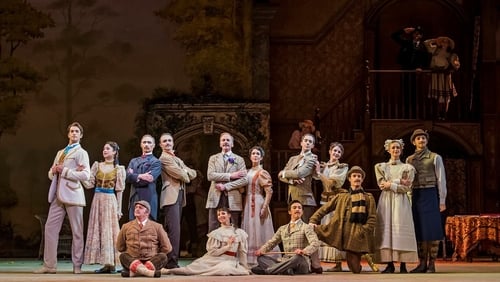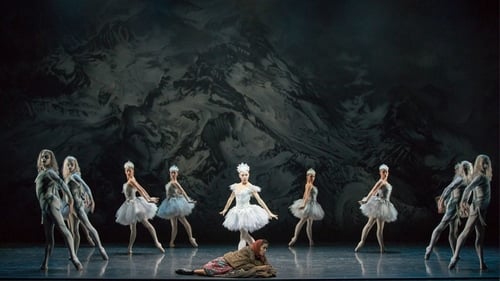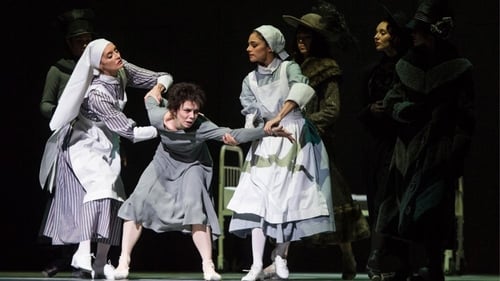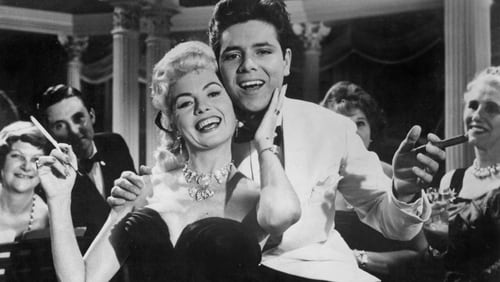Kenneth MacMillan
Birth : 1929-12-11, Scotland, UK
Death : 1992-10-29
History
Sir Kenneth MacMillan was a British ballet dancer and choreographer who was artistic director of the Royal Ballet in London between 1970 and 1977, and its principal choreographer from 1977 until his death. Earlier he had served as director of ballet for the Deutsche Oper in Berlin. He was also associate director of the American Ballet Theatre from 1984 to 1989, and artistic associate of the Houston Ballet from 1989 to 1992.

Writer
Inspired by dark and gripping real life events, this Royal Ballet classic depicts the sexual and morbid obsessions of Crown Prince Rudolf leading to the murder-suicide scandal with his mistress Mary Vetsera. The oppressive glamour of the Austro-Hungarian court in the 1880s sets the scene for a suspenseful drama of psychological and political intrigue as Rudolf fixates on his mortality. Kenneth MacMillan's 1978 ballet remains a masterpiece of storytelling and this revival marks 30 years since the choreographer’s death. Expect to see the Company at its dramatic finestacross potent ensemble scenes and some of the most daring and emotionally demanding pas de deux in the ballet repertory.

Choreographer
Inspired by dark and gripping real life events, this Royal Ballet classic depicts the sexual and morbid obsessions of Crown Prince Rudolf leading to the murder-suicide scandal with his mistress Mary Vetsera. The oppressive glamour of the Austro-Hungarian court in the 1880s sets the scene for a suspenseful drama of psychological and political intrigue as Rudolf fixates on his mortality. Kenneth MacMillan's 1978 ballet remains a masterpiece of storytelling and this revival marks 30 years since the choreographer’s death. Expect to see the Company at its dramatic finestacross potent ensemble scenes and some of the most daring and emotionally demanding pas de deux in the ballet repertory.

Choreographer
As members of the feuding Capulet and Montague families, Romeo and Juliet should be sworn enemies, but they fall deeply in love and marry in secret. That very day, disastrous circumstances lead Romeo to fight and kill Juliet’s cousin Tybalt, setting off a chain of events that culminate in tragedy.

Choreographer
From The Royal Ballet’s classical origins in the works of Petipa, to the home-grown choreographers who put British ballet on the world stage, this mixed programme highlights the versatility of the Company. Petipa’s Raymonda Act III is Russian classical ballet summarized in one act, full of sparkle and precise technique, while Ashton’s Enigma Variations is quintessentially British in every way – from its score by Elgar and period designs by Julia Trevelyan Oman, to Ashton’s signature style, the essence of British ballet. Concerto, MacMillan’s fusion of classical technique with a contemporary mind, completes a programme that shows the breadth of the Company’s heritage.

Writer
Based on the true story of the death of Crown Prince Rudolf and his young mistress Mary Vetsera in 1889, Steven McRae and Sarah Lamb take on these challenging roles in a dark and intense ballet. Crown Prince Rudolf of Austria-Hungary is emotionally unstable and haunted by his obsession with death. He is forced to marry Princess Stephanie. Soon afterwards, his former lover, Marie Larisch, introduces him to a new mistress, Mary Vetsera, a young woman who shares his morbid fascination.

Choreographer
Based on the true story of the death of Crown Prince Rudolf and his young mistress Mary Vetsera in 1889, Steven McRae and Sarah Lamb take on these challenging roles in a dark and intense ballet. Crown Prince Rudolf of Austria-Hungary is emotionally unstable and haunted by his obsession with death. He is forced to marry Princess Stephanie. Soon afterwards, his former lover, Marie Larisch, introduces him to a new mistress, Mary Vetsera, a young woman who shares his morbid fascination.

Choreographer
Kenneth MacMillan's passionate choreography for Romeo and Juliet shows The Royal Ballet at its dramatic finest. Sergey Prokofiev's iconic score provides the basis for the ballet's romantic pas de deux and vibrant crowd scenes, while 16th-century Verona is created by Nicholas Georgiadis's magnificent designs. In 1965, MacMillan's Romeo and Juliet was given its premiere at Covent Garden by The Royal Ballet and was an immediate success: the first night was met with rapturous applause, which lasted for 40 minutes, and an incredible 43 curtain calls. The title roles were danced by Rudolf Nureyev and Margot Fonteyn, although the ballet had been created on Christopher Gable and Lynn Seymour. It has been performed by The Royal Ballet more than four hundred times since, as well as touring the world, and has become a true classic of the 20th-century ballet repertory.

Choreographer
"Handsomely staged, meticulously rehearsed and vividly danced" (The Spectator), English National Ballet's production of Kenneth MacMillan's ballet features compelling characters, larger than life scenes and pas de deux ranging from romantic to heartbreaking.
The ballet's haunting score, by Jules Massenet, is played live by English National Ballet Philharmonic under the baton of Gavin Sutherland.

Story
Manon’s brother Lescaut is offering her to the highest bidder when she meets Des Grieux and falls in love. They elope to Paris, but when Monsieur G.M. offers Manon a life of luxury as his mistress she can’t resist.

Choreographer
Manon’s brother Lescaut is offering her to the highest bidder when she meets Des Grieux and falls in love. They elope to Paris, but when Monsieur G.M. offers Manon a life of luxury as his mistress she can’t resist.

Choreographer
Inspired by Hans Christian Andersen's fairytale The Ice Maiden, The Fairy's Kiss tells the story of a boy cursed with a kiss, destined for immortality.

Choreographer
Royal Ballet Principal Natalia Osipova dances the title role in Kenneth MacMillan’s haunting ballet, to atmospheric music by Tchaikovsky and Martinů. Anastasia tells the story of Anna Anderson who, following the Russian Revolution and the murder of the royal family, claimed she was the surviving Grand Duchess Anastasia. Many believed her to be an imposter; others hoped she was Anastasia, a remnant of a lost world. A powerful, psychological challenge for the lead dancer, Anastasia explores one of the great historical mysteries of the 20th century, only recently solved, and the distorting mirror of memory, time and place.

Choreographer
Given its premiere by The Royal Ballet in 1965 with Rudolf Nureyev and Margot Fonteyn dancing the title roles, Kenneth MacMillan's first full-evening ballet has become a signature work for the Company, enjoying great popularity around the world. From the outset, the production teems with life and colour as the townspeople, market traders and servants of the rival Montagues and Capulets go about their daily business in vibrant crowd scenes. But Romeo and Juliet take centre stage for those great pas de deux: the meeting in the ballroom, the balcony scene, the morning after the wedding and the final devastating tomb scene. Although The Royal Ballet has performed Romeo and Juliet over 400 times, each performance and pairing is subtly different and Lauren Cuthbertson and Federico Bonelli are utterly captivating in the title roles.

Writer
"MacMillan's vision has been vital in shaping The Royal Ballet's style and repertory, and what better way to appreciate his art than with this rare chance to experience three contrasting works in a single performance. Abstract, dramatic, humorous - this programme gives a wonderfully varied introduction not just to MacMillan's work but to the beauty and dramatic power of ballet itself. Concerto, to Shostakovich's Second Piano Concerto, contrasts moments of exuberance and elegiac reflection. The Judas Tree places a single woman among 13 men to enact a harrowing event that is recognizably contemporary but with biblical overtones. Elite Syncopations completes the programme with a sparkling evocation of a dance hall that brings ragtime rhythms to the dance, and a ragtime band to the stage.

Choreographer
"MacMillan's vision has been vital in shaping The Royal Ballet's style and repertory, and what better way to appreciate his art than with this rare chance to experience three contrasting works in a single performance. Abstract, dramatic, humorous - this programme gives a wonderfully varied introduction not just to MacMillan's work but to the beauty and dramatic power of ballet itself. Concerto, to Shostakovich's Second Piano Concerto, contrasts moments of exuberance and elegiac reflection. The Judas Tree places a single woman among 13 men to enact a harrowing event that is recognizably contemporary but with biblical overtones. Elite Syncopations completes the programme with a sparkling evocation of a dance hall that brings ragtime rhythms to the dance, and a ragtime band to the stage.

Choreographer
The Royal Ballet performs a production of Manon, starring Tamara Rojo in the title role with the world-famous dancer Carlos Acosta as her lover Des Grieux. In decadent 18th century Paris, the young, beautiful and naive Manon is torn between a life of privilege and luxury with the wealthy Monsieur GM or love with the poor student Des Grieux. Manon has become one the Royal Ballet's signature works since its creation by choreographer Kenneth MacMillan in 1974. This typically sumptuous production is designed by Nicholas Georgiadis and staged by Monica Mason and Monica Parker.

Choreographer
Carlos Acosta dances as one of the two star-crossed lovers in Shakespeare's timeless tragedy, presented with the classic Kenneth MacMillan choreography and beautifully staged by The Royal Ballet. In this perennial favourite, Carlos Acosta dances alongside Tamara Rojo in a celebrated stage partnership. The drama of the doomed lovers is set against the ravishing sets and costumes designs of Nicholas Georgiadis.

Choreographer
The Sleeping Beauty unites Petipa's demanding but enchanting choreography with Tchaikovsky's wonderful score in one of the best-loved of all classical ballets. This recording of Anthony Dowell's 1994 production for The Royal Ballet, with designs by Maria Björnson, features an outstanding cast led by Viviana Durante as a radiant Princess Aurora. She is partnered by Zoltán Solymosi as Prince Florimund and Anthony Dowell himself is a glitteringly elegant embodiment of evil as the wicked fairy Carabosse. The Royal Ballet, exceptional as ever, is accompanied by the Orchestra of the Royal Opera House, deftly conducted by Barry Wordsworth.

Choreographer
As young dancers, they were best friends and fierce rivals. Deedee left the stage for marriage and motherhood, while Emma would become an international ballet icon. But when Deedee's teenage daughter is invited to join Emma's dance company and begins an affair with a young Russian star, the two women are forced to confront the choices they've made, the resentments they've hidden and the emotional truths they must face at the turning point.

Choreographer
A seedy London promoter turns a naive, working-class teenager into a pop singing sensation.

Writer
Winter Dreams is a one-act ballet created by Kenneth MacMillan in 1991 for the Royal Ballet. The music is by Pyotr Ilyich Tchaikovsky, with some traditional Russian music. The story is based on the play Three Sisters by Anton Chekhov. The first performance was on 7 February 1991, at the Royal Opera House, Covent Garden.

Choreographer
Winter Dreams is a one-act ballet created by Kenneth MacMillan in 1991 for the Royal Ballet. The music is by Pyotr Ilyich Tchaikovsky, with some traditional Russian music. The story is based on the play Three Sisters by Anton Chekhov. The first performance was on 7 February 1991, at the Royal Opera House, Covent Garden.

Choreographer
Romeo and Juliet fall passionately in love, but their families are caught up in a deadly feud. They marry in secret, but tragic circumstances lead Romeo to fight and kill Juliet’s cousin Tybalt. As punishment, he is banished from the city. When Juliet’s parents force her to marry Paris, she takes drastic action by drinking a potion to make her appear dead so she can escape to join Romeo. News of the plan fails to reach him and he returns to visit her tomb grief stricken. Presuming Juliet lifeless, he drinks a phial of poison. Juliet wakes to find Romeo dead. Devastated, she stabs herself.










